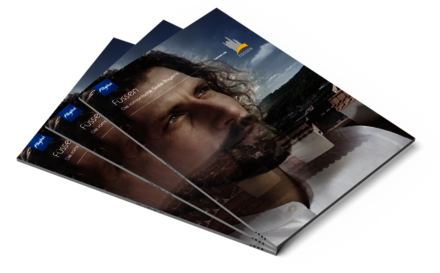The Lech
The Lech has always been the lifeline of the villages and towns through which it flows. The wild river was formed by the Lech Glacier, which covered the area between today's Lech and the Iller. It rises near the Formarinsee lake in Vorarlberg, Austria, then shapes one of the last wild river landscapes in Europe - the Lech Valley - before continuing on to Augsburg via the Lech Falls in Füssen and finally flowing into the Danube at Rain. The fascinating thing about this "last wild river" is above all its color: magical light blue-turquoise to jade green. The Lech owes this to two factors: firstly, the high content of minerals in the water, which the Lech dissolves from its stones, and secondly, the low water temperature. The average annual temperature is only six degrees Celsius.
Then as now, the Lech also has an economic significance. As early as the Middle Ages, raftsmen from Füssen transported timber and merchandise downstream to the Danube. Today, the Lech is primarily used to generate energy. The Forggensee, which was dammed for the first time in 1954, serves as a head reservoir for the downstream Lech power station and regulates the water flow.
The Lech Falls are well worth a visit. The Lech falls over five steps into a narrow gorge via a barrage built in the 18th century. The "Magnustritt" is also located at the Lech Falls. This is where St. Magnus, the apostle of the Allgäu and founder of the first Christian cell on Füssen soil, is said to have jumped over the Lech with a mighty leap while fleeing. The legend can be recognized by an oval depression - the jumping point - in the bank rock.
The Lech
The Lech Falls
At the Lech Falls in Füssen, the mountain river shows its wild origins one last time before it is finally tamed by the dam walls of Lake Forggensee. Here in Füssen, the Lech forces its way through a narrow gorge before leaving the Alps. At this point, the river was dammed up at the end of the 18th century by an artificial weir for the use of hydropower. The weir replaced the natural cataract and today forms the Lech Falls. Over five steps, the water masses of the Lech Falls plunge 12 meters into the deep Lech Gorge near Füssen. Unlike the dam, the Lech Gorge near Füssen is of natural origin. At the end of the last ice age, the glacial lake that covered the entire Pfronten valley floor flowed into the Alpine foothills at this exact point. Over the millennia, the water carved today's gorge into the rock.
The König-Max-Steg crosses the Lech directly above the Lechfall. The bridge over the Lech Falls offers an insight into the impressive Lech Gorge. In the other direction, the view opens up to the turquoise Lech in its last natural environment as a wild river. The footbridge was built over the Lech back in 1895. A bust of its namesake, King Maximilian, was embedded directly into the rock at the Lech Falls.
Life track Lech in Füssen in the Allgäu
In the portal town of Füssen, the focus is on the balance of body, mind and soul. The mainstay of Füssen's health offerings are the Kneipp pillars of movement, water and, above all, inner order. In various Kneipp experience areas, visitors can enjoy exercise trails, Kneipp treading pools and islands of tranquillity. Certified sleep hosts offer specially equipped guest rooms and coordinated services on the subject of good and healthy sleep in their accommodation.
Leaflets and flyers
View, download or order brochures, local maps and leaflets.













